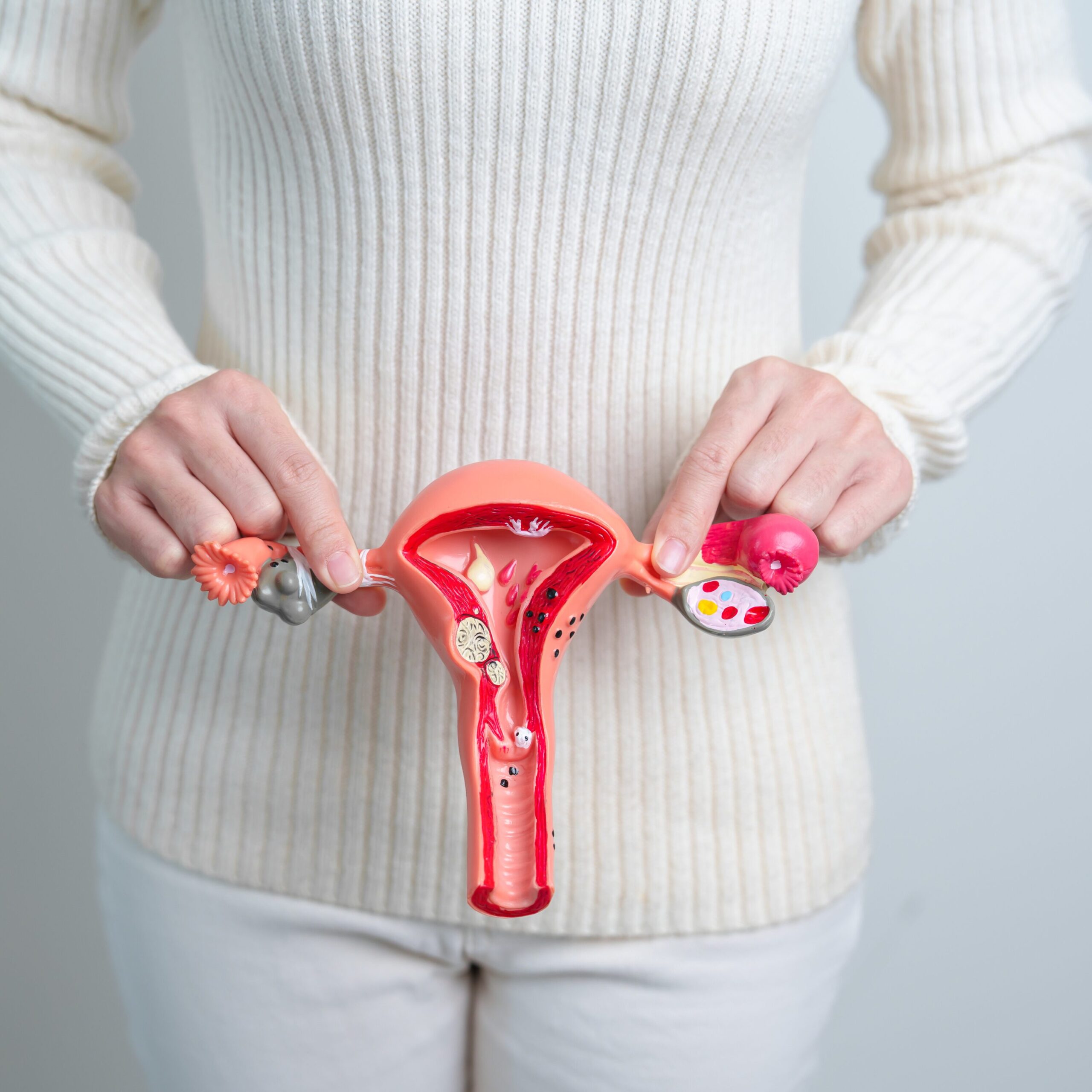Dealing with a major surgery like a hysterectomy after menopause can be a challenging and emotional experience for women, especially those who are older. Understanding why women undergo hysterectomies, the different types of hysterectomies, and the associated risks is crucial to handling this phase. In this article, we will share more about these topics and treatment options for menopausal symptoms.
Why Women Undergo Hysterectomy
Hysterectomy is a surgical procedure in which the uterus is removed. It is typically recommended to address various medical conditions such as uterine fibroids, endometriosis (endometrial cancer), adenomyosis, uterine prolapse (uterine cancer), and certain gynecologic cancers. Women facing these conditions may experience traumatic symptoms that significantly affect their quality of life, leading to the need for hysterectomy.
- Uterine Fibroids: These are non-cancerous growths that gradually form over time. It causes heavy bleeding, pain and sometimes infertility. There are treatment methods for fibroids like oral birth control pills, or a myomectomy which removes only the fibroid and leaves the uterus intact. A hysterectomy can only be carried out if the treatment methods prove ineffective and the fibroid regrows.
- Endometriosis: This is a condition where tissue (endometrial lining) grows outside the uterus rather than line the inner wall of the uterus. A Physician will recommend alternative treatment options to remove endometrial tissue before a hysterectomy.
- Adenomyosis: Adenomyosis occurs when the lining of the uterus grows into the muscle of the uterus, causing the uterine wall to thicken. This leads to pain and heavy bleeding. While this condition often goes away after menopause, symptoms can be severe and hysterectomy can be an option.
- Uterine Prolapse: This happens when the uterus slips from its usual position and falls into the vagina. This is common in people who have had more vaginal births than C.S, or people who are obese and are undergoing menopause.
Different Types of Hysterectomies
There are several types of hysterectomies, each with its own approach and recovery process.
Abdominal hysterectomy
Abdominal hysterectomy, otherwise known as an open procedure, is the traditional method involving a large incision, resulting in a longer recovery time. The uterus is removed through a cut in the lower belly.
Laparoscopic hysterectomy
Laparoscopic surgery or Robotic-assisted laparoscopic hysterectomy is less invasive and involves several small incisions, allowing for faster recovery. The doctor uses a lighted tube and other surgical tools to remove the uterus.
Vaginal hysterectomy
Vaginal hysterectomy is the least invasive option and involves removing the uterus through the vagina. During this surgery, the surgeon detaches the uterus from the ovaries, fallopian tubes, and upper vagina. The blood vessels and connective tissues supporting the uterus is removed too. It involves a shorter recovery time and lesser cost.
Radical hysterectomy
This type of hysterectomy is performed to treat gynecologic cancers and may include removing the cervix, fallopian tubes, and upper portion of the vagina along with the uterus
While these are common types of hysterectomy. They can be grouped into two, namely:
-
Supracervical hysterectomy:
Involves the removal of the uterus while leaving the cervix intact. Otherwise known as a partial hysterectomy.
-
Total Hysterectomy:
This is the removal of the entire uterus, including fallopian tubes and the cervix.
Understanding these types of hysterectomy can help you prepare mentally and physically for the surgery and its aftermath with your healthcare provider.
Risks Associated with Hysterectomy
Like any surgical procedure, a hysterectomy carries some risks. These risks may include infection, bleeding, damage to surrounding organs, and adverse reactions to anesthesia. A hysterectomy could trigger menopause and cause blood clots that might need to be removed surgically later. You would undergo some degree of discomfort, wearing light pads, avoiding sex, and avoiding work. It is essential for women considering hysterectomy to have a thorough discussion with their healthcare provider about the potential risks and how they can be mitigated.
The Relationship Between Hysterectomy and Menopause
Hysterectomy can have an impact on menopause. If the ovaries are removed along with the uterus (oophorectomy), the woman may experience surgical menopause, as the sudden loss of estrogen production leads to menopausal symptoms. However, if the ovaries are preserved, women may still experience menopause at their natural time, but the absence of the uterus may result in changes to the menstrual cycle.
Is Getting a Hysterectomy After Age 60 Safe?
Many women wonder if it is safe to undergo a hysterectomy after the age of 60. Age alone does not determine the safety of the procedure. The decision to proceed with a hysterectomy should be based on an individual’s overall health, medical condition, and the impact of symptoms on their well-being. As regards menopause, 60 is above the average age of menopause, so it’s more likely that surgical menopause occurs after surgery. It is important for women in this age group to have a thorough discussion with their healthcare provider to assess the risks and benefits.
Hormonal Changes After Hysterectomy
After hysterectomy, women may experience hormonal changes due to the removal of the uterus and, in some cases, the ovaries. These changes can result in menopausal symptoms such as hot flashes, vaginal dryness, mood swings, and sleep disturbances. Understanding these hormonal fluctuations can help women better cope with the physical and emotional changes they may experience.
The first hormonal change is the plummet in the level of estrogen and progesterone. This loss results in hot flashes, depression, brain fog, depression, fatigue, and sagging skin.
To adjust to these changes, there are many diets women can experiment with, like a diet high in protein and fiber to reduce inflammation and regulate weight. Taking food including flaxseed and soybeans can help relieve some symptoms related to estrogen loss. Some physicians also recommend estrogen replacement therapy or a systemic hormone therapy that suits your needs.
What Does No One Tell You About a Hysterectomy
There are aspects of hysterectomy that may come as a surprise to some women. The impact on sexual function and libido is a topic that is often not talked about openly. It is important for women to have open and honest discussions with their healthcare provider about any concerns or questions they may have regarding post-hysterectomy sexual health.
It’s Not the End of Sex
Yes, the surgery will have almost permanent effects on your body but may not affect your sex life. If your cervix was not removed along with your uterus, you can discuss with your doctor, the waiting period to get back to sex. If the cervix was not removed, the recovery period is about four weeks (30 days after surgery) to start having sexual intercourse while it can take about six weeks (50 to 60 days after surgery) if the cervix was removed. You can ask your doctors to specify what sexual activities you can partake in to avoid pain during sex.
Surgical Menopause is not a Certainty
There’s a myth about women going into menopause after the surgery but this is an extravagated truth. While some women experience severe menopause symptoms, others barely notice any symptoms after a hysterectomy. Signs of menopause like hot flashes, sagging skin, blood clots, and depression are often times not experienced and the weeks after surgery come with less pain. A hysterectomy increases the likelihood of natural menopause as it reduces ovarian function, but immediate menopause is more attributed to the factors that made the hysterectomy necessary at first.
Tips to Manage Hysterectomy After Menopause
Navigating the physical and emotional effects after a hysterectomy can be challenging for women, particularly those over the age of 60. Some practical tips include:
- Engage in regular exercise to promote bone health and overall well-being. Be sure to avoid strenuous exercise.
- Maintain a healthy diet rich in calcium and vitamin D to support bone density.
- Seek emotional support from friends, family, or support groups to cope with any emotional challenges.
- Consider pelvic floor exercises to strengthen the pelvic muscles and alleviate any urinary incontinence issues.
- Consider treatment with hormone therapy after surgery.
Treatment Options for Menopausal Symptoms
Hormone Replacement Therapy (HRT) is one treatment option for managing the common side effects after hysterectomy. HRT replaces the hormones aftter the drastic drop in hormone levels. However, it is essential to discuss the risks and benefits of HRT with a healthcare provider as it may not be suitable for everyone. A HRT is useful for patients less than the age for menopause (51 years old) or above the age. Additionally, lifestyle changes such as maintaining a healthy weight, engaging in stress reduction techniques, and incorporating holistic therapies may also help alleviate menopausal symptoms.
Dealing with hysterectomy after menopause can be a complex journey for women. By understanding the reasons for hysterectomy, the different types of procedures, and the associated risks, women can better prepare themselves for the surgery. Moreover, acknowledging the relationship between hysterectomy and menopause, the hormonal changes that may occur, and exploring treatment options can significantly ease the transition and improve your mental health.



